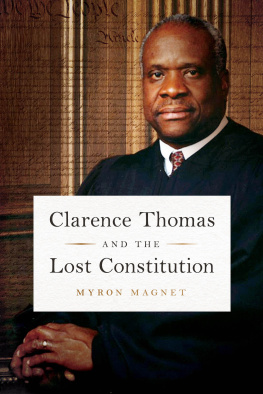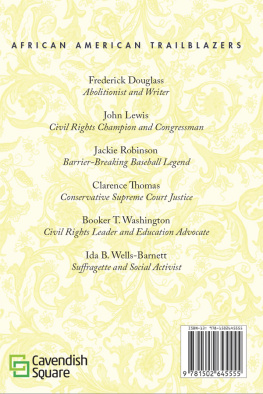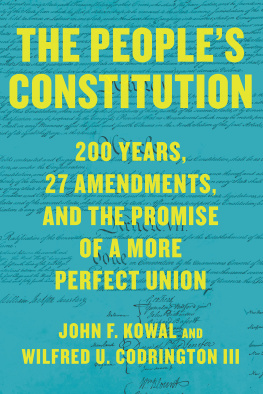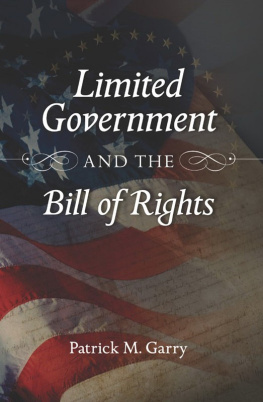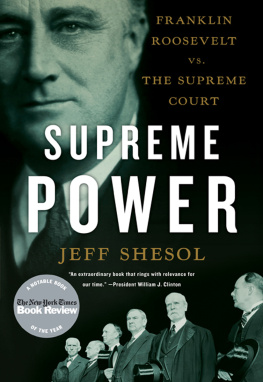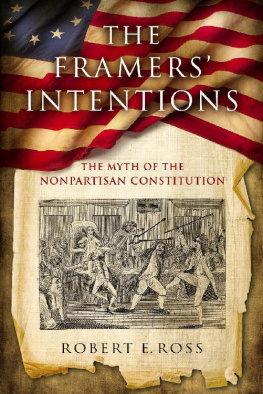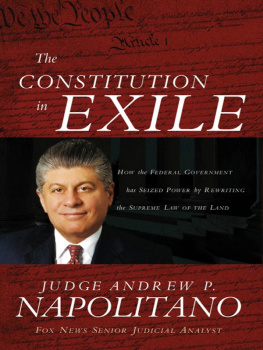
Clarence Thomas
and the
Lost Constitution
Also by Myron Magnet
The Founders at Home: The Building of America, 17351817
The Dream and the Nightmare: The Sixties Legacy to the Underclass
Dickens and the Social Order
Edited by Myron Magnet
The Immigration Solution: A Better Plan Than Todays
Modern Sex: Liberation and Its Discontents
What Makes Charity Work? A Century of Public and Private Philanthropy
The Millennial City: A New Urban Paradigm for 21st-Century America
Clarence Thomas
and the
Lost Constitution
Myron Magnet
2019 by Myron Magnet
All rights reserved. No part of this publication may be reproduced, stored in a retrieval system, or transmitted, in any form or by any means, electronic, mechanical, photocopying, recording, or otherwise, without the prior written permission of Encounter Books, 900 Broadway, Suite 601, New York, New York, 10003.
First American edition published in 2019 by Encounter Books, an activity of Encounter for Culture and Education, Inc., a nonprofit, tax exempt corporation.
Encounter Books website address: www.encounterbooks.com
Manufactured in the United States and printed on acid-free paper. The paper used in this publication meets the minimum requirements of ANSI/NISO Z39.481992 (R 1997) (Permanence of Paper).
FIRST AMERICAN EDITION
LIBRARY OF CONGRESS CATALOGING-IN-PUBLICATION DATA
Names: Magnet, Myron, author.
Title: Clarence Thomas and the lost constitution / by Myron Magnet.
Description: New York : Encounter Books, 2019. | Includes bibliographical references and index.
Identifiers: LCCN 2018050003 (print) | LCCN 2018051114 (ebook) | ISBN 9781641770538 (ebook) | ISBN 9781641770521 (hardcover : alk. paper)
Subjects: LCSH: Thomas, Clarence, 1948- | United States. Supreme Court--Officials and employees--Biography. | African American judges--Biography. | Constitutional law--United States.
Classification: LCC KF8745.T48 (ebook) | LCC KF8745.T48 M34 2019 (print) | DDC 347.73/2634 [B] --dc23
LC record available at https://lccn.loc.gov/2018050003
In Memoriam
Barbara Crehan Magnet
19462016
Contents
CHAPTER ONE
Our Crisis of Legitimacy
W ell before his fellow Englishmen had grasped it, Economist founding editor Walter Bagehot observed that Britain really had two governments, one for show, one for real. The dignified government, he explained in his 1867 classic, The English Constitution, is the storied monarchy, with its pageantry of thrones and crowns, gilded coaches and showy guardsmenbut no power. The efficient government, which actually runs the realm, is the prime minister and his cabinet, mostly non-aristocrats who go about their business quietly in the shadows, bland men in sober suits (plus Jaguars with drivers today).
Something like that has developed in America, too. But while in Bagehots England the two governments strengthened each other, the monarchy cloaking the efficient government in its venerable authority, in America the two have become so increasingly opposed that the disjunction now threatens a crisis of legitimacy. Though that crisis has long been brewing, the 1991 Senate hearings on Clarence Thomass Supreme Court nomination first brought it into view, hazily. What was at stake to rouse such ferocity and lead the Judiciary Committee Democrats to sink to the politics of personal destruction, with almost no norm of decorum left intact, to smear Thomass character rather than weigh his fitness as a jurist?
What led them to follow exactly the same playbook in the 2018 Brett Kavanaugh hearings, willing not only to ambush the judge at the eleventh hour with sordid, uncorroborated allegations of sexual transgressions as a teenager 36 years earlier but also to withhold from his chief accuser the key fact that she did not have to submit to humiliating public questioning in Washington but could have testified privately in her home state, as she requested? To those who used her as a mere tool of demolition, who farcically endorsed the hysterical shrieking of professional demonstrators in the gallery as the sound of democracy, she was just as disposable as Kavanaugh, mere roadkill. Even the biased journalists dishing out fairy tales of yet more alleged debauchery and falsely inflating the main allegation into an attempted-rape charge, far graver than what the accuser described, included hardened veterans of the Thomas slander.
In the aftermath of this squalid spectacle, Left and Right are scarcely on speaking terms, and the anger isnt likely to fade anytime soon. Thats because, as Americans are coming to recognize from the spotlight on the Court, Left and Right have visions of government so different that they cant be reconciled easily. One diagnostic index is Hillary Clintons assertion that You cannot be civil with a political party that wants to destroy what you stand for, what you care about. Another is Senator Cory Bookers claim that to support Kavanaugh is to be complicit with evil.on fellow riders to taunt him threateningly for the villainy of his political incorrectness. la lanterne!
HOW DID THIS divide happen? The answer lies in how immeasurably far weve traveled from our national ideal.
Start from the Founding Fathers original vision of a democratic republic governed by the peoples own elected representatives, charged with protecting citizens inborn rights to life, property, and the liberty to work out their individual happiness themselves, in their families, communities, and states. Wary of government power after their colonial experience of arbitrary rule, the founders at first overcautiously formed a national regime so weak that it almost lost the Revolutionary War, and victory cost much more blood and suffering than in retrospect seemed necessary. So in 1787, they wrote a new Constitution, framing a central government strong enough to fight a war and fund it, but fenced round with limits to prevent its becoming the elective despotism they feared. As James Madison put it, because men are not angelsbecause they can (and do) rob, rape, kill, and conquerthey need a government to restrain and protect them, an institution to make people do their duty. But since such an institution is made up of imperfect human beings with the same unruly passions as anyone else, In framing a government of men over men, the great difficulty lies in this: You must first enable the government to control the governed; and in the next place, oblige it to control itself.
We all learn about how the Constitutions framers accomplished that delicate balance through the three branches of government and the separation of their powers: democratically elected representatives frame laws to do the voters will, which the elected president executes, unless the Supreme Court deems them unconstitutional. But that small government of limited and enumerated powers hasnt operated for nearly a century. All its parts still have their old names and appear to be carrying out their old functions. But in reality, a new kind of government has grown up inside the old structure, like those parasites hatched in another organism, which grow to maturity by eating up their host from within, until the adult creature bursts fully formed out of the hosts carcass. The transformation that takes place is not an evolution but a usurpation.
Next page
